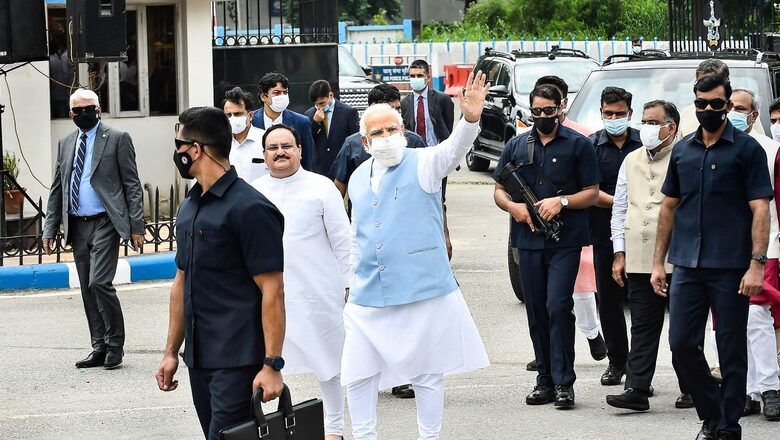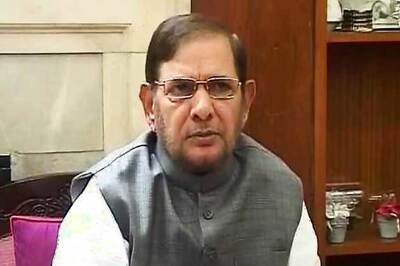
views
October 7 marks Prime Minister Narendra Modi’s 20 years in public life. In the last two decades, from being a hard-working chief minister, he has gone on to become a towering global personality. He has become the longest-serving head of an elected government, fourth longest-serving Prime Minister and the longest serving non-Congress Prime Minister of India. During 2001 to 2014, he served 4,607 days as the chief minister of Gujarat. He was elected as the 14th Prime Minister of the country in 2014 and since then he has been in office. He enjoys mass appeal like no other leader, neither in the party nor in the country.
When he took the baton of Gujarat in 2001, the state was ruined by a devastating earthquake and then struggling with economic disruption due to communal violence in 2002. To revive the state, he conceptualized and held a state-level conclave ‘Vibrant Gujarat Global Investors Summit’ (VGGIS) in 2003 to attract investment and to build investors’ confidence. The result of the efforts made by him was that Gujarat registered an impressive double digit growth during 2004-05 to 2011-12. The growth rate peaked at 15 per cent in 2005-06. According to IBEF, Gujarat is one of the high growth states and a leading industrialised state in the country. It is estimated that Gujarat’s GDP will grow by 7 per cent YoY and will reach at Rs 18.80 lakh crore in FY22.
ALSO READ | The Modi Reset in Indian Politics: Not Caste or Religion but Winning on Governance
The Gujarat development model has always been a subject of discussion. The Gujarat model made such a splash in the 2014 General Election to the Lok Sabha that it pushed Modi to the pinnacle of power. As in Gujarat, Modi found the Indian economy too in a dilapidated condition. In 2014, our economy was bracketed with the worst performing economies. The economy was going through challenging times that culminated in lower than 5 per cent growth of GDP at factor cost at constant prices for two consecutive fiscals – FY13 and FY14. Wholesale price index inflation in food articles that averaged 12.2 per cent annually during 2008-09 to 2013-14 was significantly higher than non-food inflation.
To cope with the problems and push the economy towards growth, the Narendra Modi government initiated a number of reforms, including reforms in labour laws and agriculture sector. It is as a result of these second-generation economic reforms that although we suffered the shock of global pandemic, our economy is still moving towards a ‘V’-shaped recovery. Moody’s Investor Service on October 5 changed its outlook on the sovereign rating of India to stable from negative. The outlook upgrade is a positive sign that incorporates government’s consistent assessment about the strong fundamentals of the economy. Post-pandemic, our economy is one of the fastest growing economies in the world and is out of the woods, and is expected to achieve double-digit growth on a sustainable basis. Aatmanirbhar Bharat initiative of Narendra Modi is providing great fillip to the economy.
His major initiatives are—Insolvency and Bankruptcy code, Goods and Services Tax, labour reforms, farm laws, new education policy. All these reforms by the government firmly establish Prime Minister Modi as a reformist prime minister.
Our banks and financial institutions were besieged by huge NPAs, their balance sheets were in doldrums and were under capitalised to a large extent, effecting their lending capacity. Narendra Modi government took important initiative in identification and recognition of bad loans and working towards their resolution on war footing. New and effective laws were enacted, such as the Fugitive Economic Offenders Act, Notification of Benami Properties Act and Insolvency and Bankruptcy Code (IBC), which has revolutionised the business ecosystem, provided easy entry and exit route for businesses. The Code was enacted in 2016 and further amended in April 2021 to provide for pre-packaged insolvency resolution processes for corporate MSMEs. Since 2016, a total of 4,541 corporate insolvency resolution processes (CIRPs) have started and by June 2021, 2,859 have been closed. Of the 2,589 closed cases, 653 were closed on appeal, 461 withdrawn, 1349 ended in order for liquidation and 396 ended in approval of resolution plans.
The Code applies to company, partnership and individual and provides for a time-bound process to resolve insolvency. Data reveals that SCBs (scheduled commercial banks) have been able to recover 49.6 per cent in FY18, 45.7 per cent in FY19 and 45.5 per cent in FY20 of the amount involved through IBC, which is the highest as compared to recovery under other modes and legislation. The financial creditors have benefited through higher realisation on account of the Code and lowering of NPAs in their balance sheets. The gross NPAs that reached a peak of 11.2 per cent in FY18 had been steadily declining and reached 7.5 per cent in FY21.
The main aim of the Code is rescuing lives of corporate debtors (CDs) in distress. The code has rescued 396 CDs by June 2021. The assets value for the same is Rs 1.46 lakh crore. However, 1349 CDs of asset value of Rs 0.49 lakh crore have been referred for liquidation.
ALSO READ | Modi Model: 20 Years of Efficient and Effective Governance
The efforts made by the government were recognised by the World Bank in its ‘Doing Business Report’ (DBR). As per DBR 2020, India made a huge leap in its ranking in resolving insolvency parameters to 52nd position against 103rd position in 2008 and 136th in 2017. The 2020 edition of Global Innovation Index also indicates an improvement in the country’s rank in ‘ease of resolving insolvency’, to 47th in 2020 from 91st in 2018 and 111th in 2017.
The economic growth during the Modi government has been faster as compared to the growth during the UPA-1 and UPA-II governments. The tenure of NDA-II and NDA-III governments has been historic for the country’s development. India is seeing huge flow of foreign investments in green field and brown field manufacturing. India is occupying second position globally as the most sought-after destination for manufacturing set-up. However, as Modi himself says, there is a lot to be done in the remaining period.
Gopal Krishna Agarwal is National Spokesperson, Bharatiya Janata Party. Vinay K. Srivastava teaches at I.T.S Ghaziabad. The views expressed in this article are those of the authors and do not represent the stand of this publication.
Read all the Latest News , Breaking News and IPL 2022 Live Updates here.




















Comments
0 comment